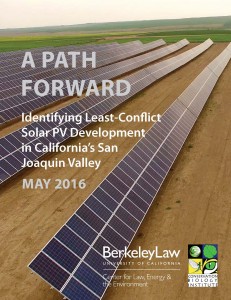Planning for Utility-Scale Solar PV in the San Joaquin Valley
Free evening panel discussion in downtown San Francisco on Tuesday June 6th, 5:30 – 7pm
California aims to generate 50 percent of its electricity from renewable sources by 2030, and a new bill now in the legislature seeks to get to 100% renewables by 2045. A significant amount of this energy will come from solar photovoltaic (PV) installations, with much of the deployment likely to occur in California’s San Joaquin Valley.
 But these facilities often engender controversy related to the loss of agricultural and biologically sensitive lands, among other conflicts. How can stakeholders and policy makers ensure that future solar PV deployment occurs only in “least-conflict” lands (which are least likely to engender objections and possibly litigation) in the San Joaquin Valley region and beyond?
But these facilities often engender controversy related to the loss of agricultural and biologically sensitive lands, among other conflicts. How can stakeholders and policy makers ensure that future solar PV deployment occurs only in “least-conflict” lands (which are least likely to engender objections and possibly litigation) in the San Joaquin Valley region and beyond?
This was a subject that Berkeley Law and Conservation Biology Institute covered in last year’s report “A Path Forward: Identifying Least-Conflict Solar PV Development in California’s San Joaquin Valley.” It is also the topic for discussion at a free evening event next week, Tuesday, June 6th, from 5:30 to 7pm at Farella Braun + Martel LLP’s downtown San Francisco office.
In addition to my overview of the report, panelists will include:
- Erica Brand, Director, California Energy Program, The Nature Conservancy
- Renee Robin, Senior Counsel, Allen Matkins
- Diane Ross-Leach, Director, Environmental Policy, PG&E Company
You can learn more about the event or register now. Space is limited, so please sign up soon if you’d like to attend.
Reader Comments
One Reply to “Planning for Utility-Scale Solar PV in the San Joaquin Valley”
Comments are closed.






Dear Ethan,
Now that America is no longer shackled by the Clean Power Plan and the Paris Agreement, what is the purpose of using expensive and unreliable solar energy when efficient low-cost natural gas energy is readily available and much more reliable?
Gas turbine power plants occupy only a few acres and do not result in the significant loss of agriculture and biologically sensitive lands that are required by large solar projects.
Natural gas power generation pays for itself and does not impose the heavy burden of tax payer subsidies that are absolutely necessary for solar. Solar power is not feasible.
Have a good day.